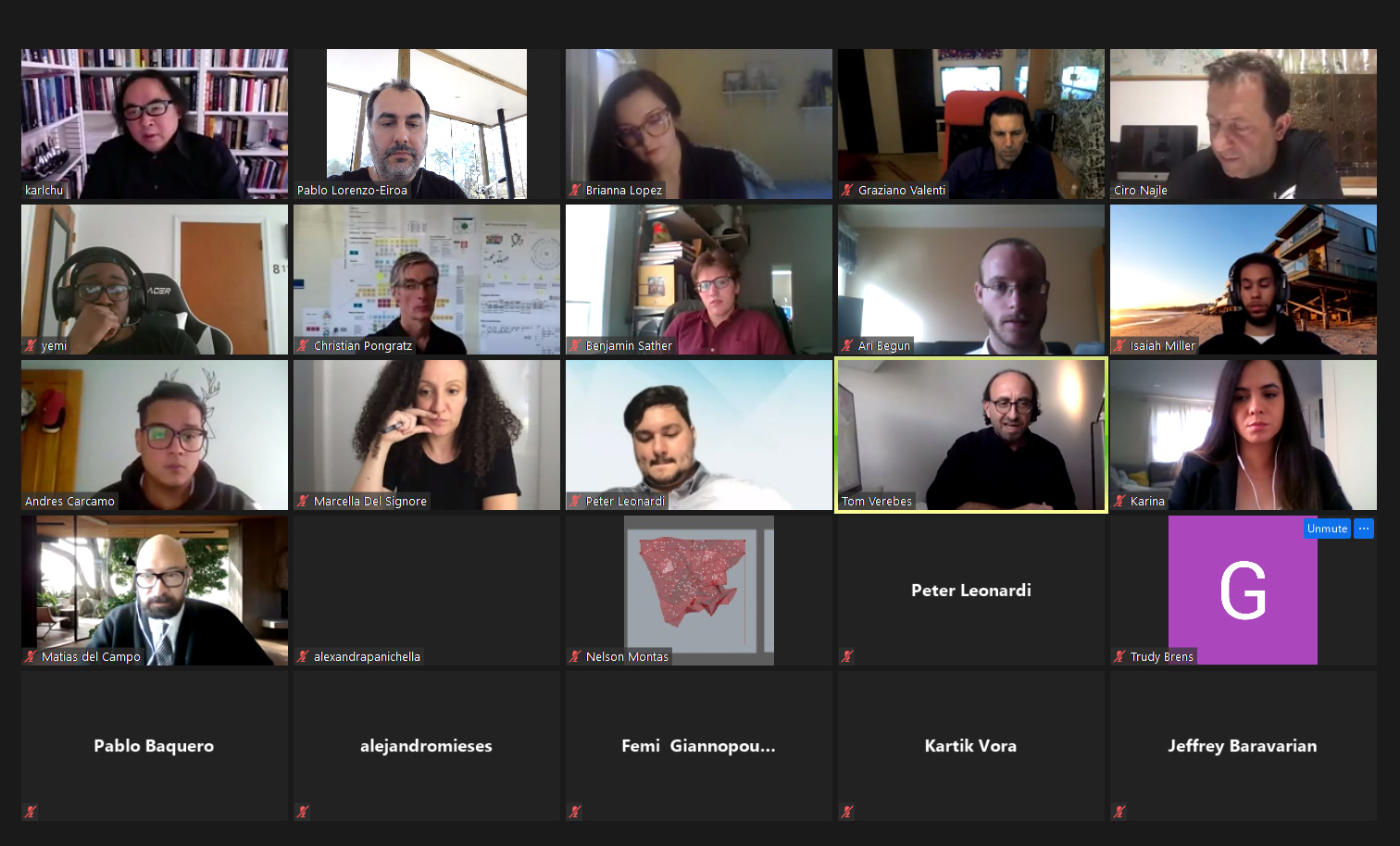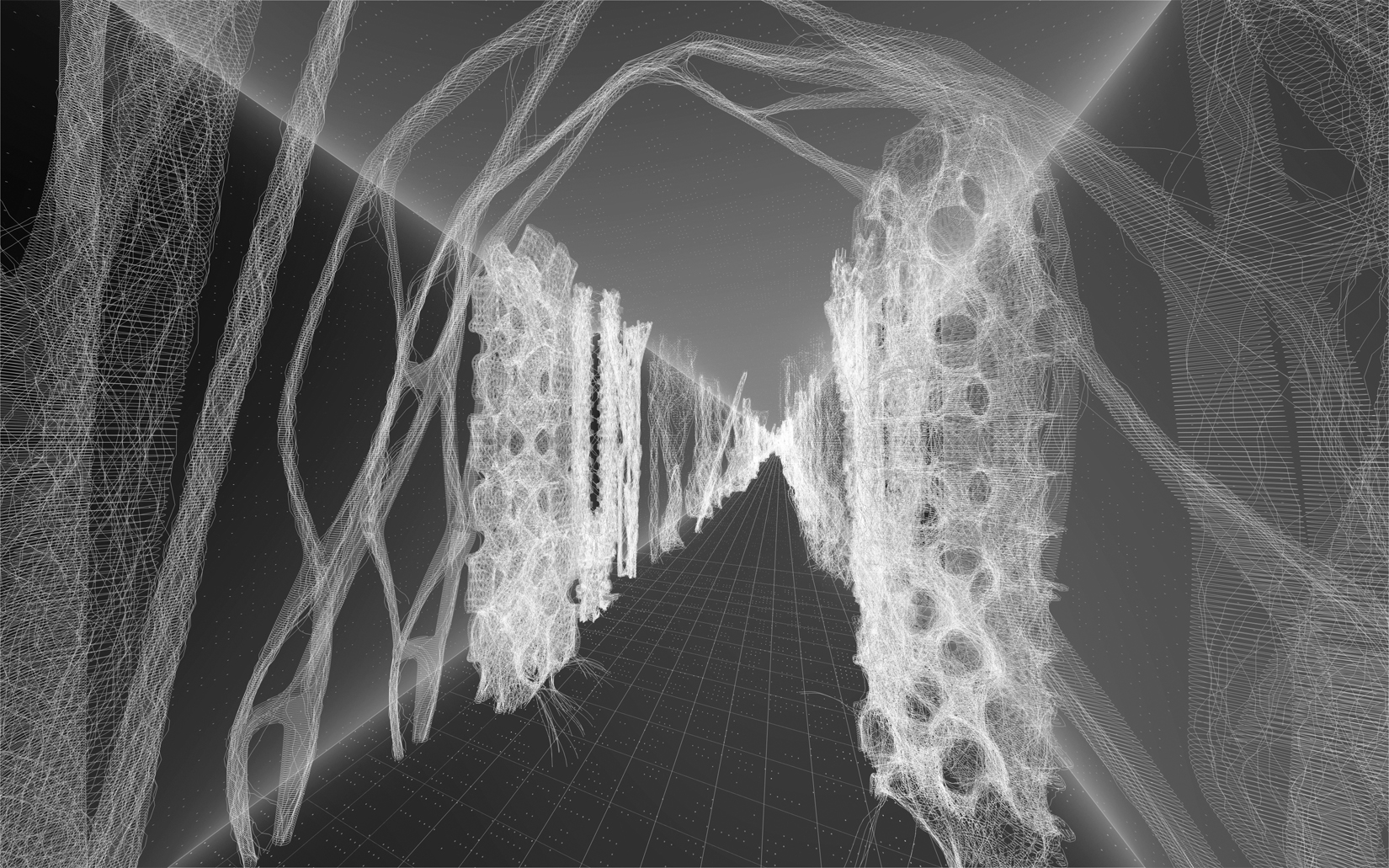Architecture Computational Technologies
Explore design research at the frontiers of architecture through experimentation in computational design, robotic systems applied to fabrication and interactivity, and materiality. For more information please contact ms.act@nyit.edu
Final Review Discussion ARC 502 S2020 Prof. Pablo Lorenzo-Eiroa
Final Review Discussion ARCH 502 Undergraduate Pilot Thesis Studio “Informed Insterscalar Fluidity”
Assoc. Prof. Pablo Lorenzo-Eiroa, NYIT SoAD
with STUDENTS: Andres Carcamo, Brianna Lopez, Peter Leonardi, Alex Pannichela,
Ari Begun, Yemi Oluwayemi Oyewole, Karina Pena, Isaiah Miller, Ben Sather
New York Institute of Technology, School of Architecture and Design
2021 Venice Biennale
The thesis studio is working on a full-scale interactive architecture installation for the “Time-Space-Existence” exhibition at the 2021 Venice Biennale curated by the Global Arts Foundation and the European Cultural Centre, to be hosted at Palazzo Bembo, Venice, Italy. The School of Architecture and Design at New York Institute of Technology is participating with an exhibition and installation entitled “Inter-scalar Fluidity”
co-curated by Associate Professors Marcella del Signore and Pablo Lorenzo-Eiroa. The exhibition and installation supported by Dean Maria R. Perbellini contribute to the Dean’s development of progressive design
thinking and cross-disciplinary computational technologies and is made possible by the S-Lab Grant funding.
Thesis Studio Brief + Studio Summary
Informed Inter-scalar Fluidity:Synthetic Space-Environments through Computational Design Simulations
This is an experimental Undergraduate Thesis studio focused on analyzing, displacing and designing computational technologies. The architecture of the installation proposes cultural projects that engage with histories and theories of the discipline, from illusionistic perspective to universal computation. In this experimental studio, computational design was extended to robotic fabrication and interactivity, working through diverse computational technologies through non-linear feedback the physical actualizations, expanding dimensions between digital programming and physical atualizations. The studio extended computational design to include robotic automated simulations, robotic fabrication and robotic interactivity in a fully immersive interactive space-environment.
The space of the installation is within a small exhibition room on the second floor of Palazzo Bembo, with dimensions of 2.50m x 4.70m. The architecture of the installation proposes cultural projects that engage with histories and theories of the discipline.Students reviewed renaissance models of illusionistic representation (Brunelleschi’s perspective) and how these models were displaced (Borromini Palazzo Spada Gallery). Through this analysis, students eventually understood discourses that presented tensions between real space and illusionistic representations of expansions of space, such as in the late baroque (Pozzo’s Anamorphosis). These studies were then integrated with other means to contain, define, structure, displace and wrap space both virtually and physically. The installation progressively resolved space as containment activating framing properties, to space defined by frame-objects such as columns that became isolated elements but that structurally frame and design the space. Certain architecture strategies were activated by scientific evidence-based design, addressing the advancement of the Modern Movement. At the same time determination and order imposition were critiqued with ideas of displacement, post-structuralist agendas of non-determination and site specificity taken at a computational representational level. The studio worked with computational simulations to critique the determination of algorithms, activating computational problems relative to irreducibility, non-reversibility and emergent evolutive-based computation based on progressive site-based generations.
The studio crossed relationships between computational digital models and computationally informed physical models, avoiding linear translations and expanding dimensions across computational technologies including materiality as a design agent. Computational design was extended to robotic fabrication and interactivity, working through diverse computational systems through non-linear feedback the physical actualizations activating material properties.
STUDENTS 2-4pm:
Andres Carcamo:
"Iconography Architecture" Brianna Lopez: "Parametric Flow"
Peter Leonardi: "Structural Typologies" Alexandra Panichella:
"Material transitions: Feedback between the Analog and the Digital"
Ari Begun: "Spatially Interactive Light"
JURORS
MARIO CARPO, Professor,
Bartlett UCL, London
CYNTHIA DAVIDSON, Director
Anyone Corporation / Editor Log, NYC
MAIDER LLAGUNO,
Principal AZPML, London
FRED LEVRAT,
Visiting Professor, Pratt Institute, NYC
SANDRA MANNINGER,
Assistant Professor of Practice, Taubman College, Ann Arbor
ALESSANDRO MELIS,
Professor of Architecture and Innovation, Portsmouth School of Architecture
GALIA SOLOMONOFF,
Associate Professor of Professional Practice, Columbia GSAAP, NYC
STUDENTS
4-6pm:
Oluwayemi Oyewole:
"Structural Optimization" Karina Pena: "Dynamics of Humidity and
Temperature Advantages" Isaiah Miller: "Sonic + Sensory"
Benjamin Sather: "[c]ellular Surfaces"
JURORS
MATIAS DEL CAMPO, Associate
Professor, Taubman College, Ann Arbor
KARL CHU, Professor UIC, Barcelona
MARCELLA
DEL SIGNORE, Associate Professor, NYIT SoAD
CIRO NAJLE, Dean, Di Tella, Buenos Aires
MARIO GRAZIANO
VALENTI, Associate Professor, Sapienza University, Rome
NYIT participants:
MARIA PERBELLINI, Dean NYIT
SoAD
TOM VEREBES, Associate Dean,
NYIT SoAD
ANTHONY CARADONNA, Assistant
Dean, NYIT SoAD
CHRISTIAN PONGRATZ, Senior
Advisor to the Provost and Professor, NYIT
More Posts
All PostsMay 31, 2022
MS_ACT INNOVATION KEYNOTE LECTURE Kaicong Wu
May 26, 2022
MS ACT Lecture Shai Yeshayahu
May 16, 2022



